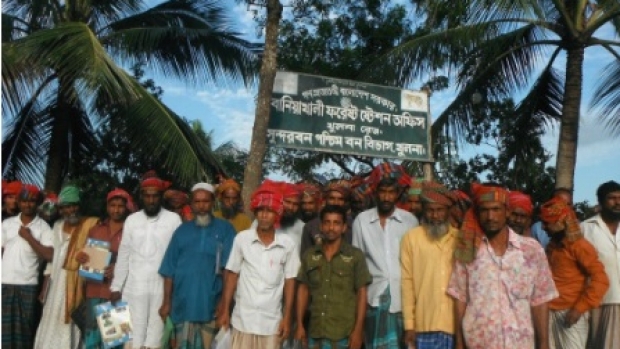Grants :: Small Grant Facilities :: Palm tree plantation in households and fodder grass experiment on shrimp farm dyke in Shyamnagar coastal area
Palm tree plantation in households and fodder grass experiment on shrimp farm dyke in Shyamnagar coastal area

Shyamnagar community wants to regain the coconut and palm tr ... , Shyamnagar, Satkhira, Bangladesh © CCEC, 2013
Objectives
Tree cover in the study sites of Shyamnagar homestead and embankment increased.
Fodder grasses and other options for shrimp farm greening and climate resilient livelihood options identified.
Background
Frequent cyclones and storm surges for example Bangladesh cyclone Sidr 2007 and cyclone Aila has damaged the agriculture, livestock, embankment, infrastructure including human death. Embankment of polder 5 in Shyamnagar, Satkhira was heavily damaged. Water logging makes the life of the Sundarbans communities especially Sundarbans resource dependant people worst. There is a need to stabilize the embankment and increase the tree coverage in the households level. Saline tolerant palm trees are recommended by the National Coordinating Bodies (NCB-MFF) to reduce climate risk in the household level and make the project visible with large scale plantation of palm trees.
Shrimp farming is now an established sector in Bangladesh. Shrimp is considered is as a high valued cash crop in the country. Bangladesh earns a huge amount of foreign currency by exporting shrimps. A large number of processing plants has been established, and a huge work force is now dependant on this sector. The sector, in fact, plays an important role in national economy. It is apparently clear that there is little scope for banning this sector and discussions centered on this issue suggest that at least shrimp farming should be made environment friendly. This has been also a priority to the foreign buyers and Bangladesh Government has commitment to this end. Therefore, there is an urgent need to make shrimp farming eco-friendly. However, there is a high demand of grass for livestock and need to conduct experiment to discover saline tolerant grass on the dyke as fodder grass.
Target beneficiaries
1300 households of Burigoalini and Munshiganj unions
Outputs
- 2000 coconut plants planted in 200 Sundarbans dependent households and care taking mechanism established
- 3000 palm seedlings planted in erosion susceptible locations of Burigoalini- Jatintranagar BWDB polder 5 and care taking mechanism established
- Dyke greening model developed and demonstrated to 100 farmers and leaflet published and distributed on dyke greening process
Contributions to cross-cutting themes
The planted palm trees will contribute to develop wind breaker against cyclones as well as source of livelihood for the targeted houeholds.
Gender equality and equity linking justice is a concern for the women beneficiaries especially empowering women in Homestead plantation.
Project Facts
Country
Location
Burigoalini and Munshiganj unions of Shyamnagar Upazila, Satkhira District
Topic
Duration
20th Sep 2013 to 19th Mar 2015
MFF Grant Amount
BDT 1,350,000